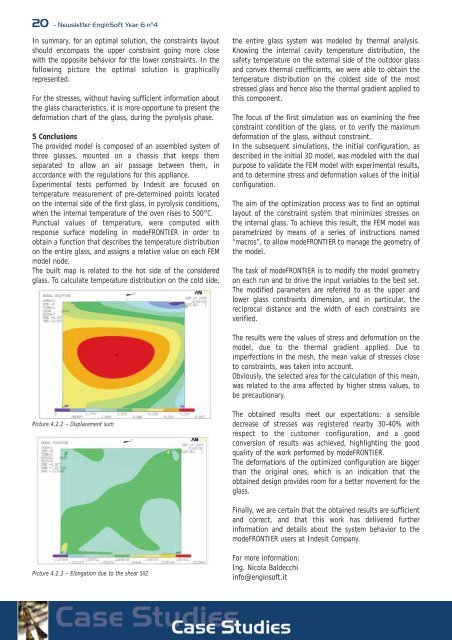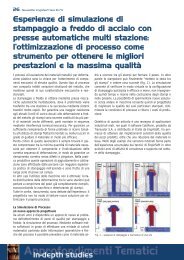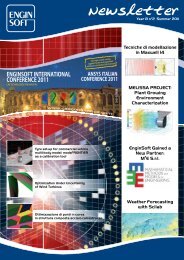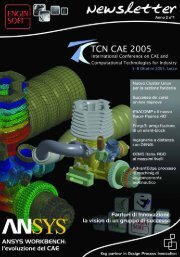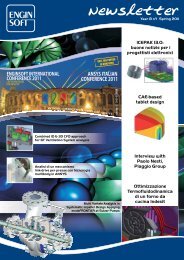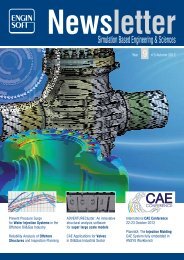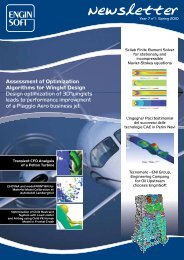software training courses 2010 corsi di addestramento ... - EnginSoft
software training courses 2010 corsi di addestramento ... - EnginSoft
software training courses 2010 corsi di addestramento ... - EnginSoft
You also want an ePaper? Increase the reach of your titles
YUMPU automatically turns print PDFs into web optimized ePapers that Google loves.
20 - Newsletter <strong>EnginSoft</strong> Year 6 n°4<br />
In summary, for an optimal solution, the constraints layout<br />
should encompass the upper constraint going more close<br />
with the opposite behavior for the lower constraints. In the<br />
following picture the optimal solution is graphically<br />
represented.<br />
For the stresses, without having sufficient information about<br />
the glass characteristics, it is more opportune to present the<br />
deformation chart of the glass, during the pyrolysis phase.<br />
5 Conclusions<br />
The provided model is composed of an assembled system of<br />
three glasses, mounted on a chassis that keeps them<br />
separated to allow an air passage between them, in<br />
accordance with the regulations for this appliance.<br />
Experimental tests performed by Indesit are focused on<br />
temperature measurement of pre-determined points located<br />
on the internal side of the first glass, in pyrolysis con<strong>di</strong>tions,<br />
when the internal temperature of the oven rises to 500°C.<br />
Punctual values of temperature, were computed with<br />
response surface modeling in modeFRONTIER in order to<br />
obtain a function that describes the temperature <strong>di</strong>stribution<br />
on the entire glass, and assigns a relative value on each FEM<br />
model node.<br />
The built map is related to the hot side of the considered<br />
glass. To calculate temperature <strong>di</strong>stribution on the cold side,<br />
Picture 4.2.2 – Displacement sum<br />
Picture 4.2.3 – Elongation due to the shear SXZ<br />
the entire glass system was modeled by thermal analysis.<br />
Knowing the internal cavity temperature <strong>di</strong>stribution, the<br />
safety temperature on the external side of the outdoor glass<br />
and convex thermal coefficients, we were able to obtain the<br />
temperature <strong>di</strong>stribution on the coldest side of the most<br />
stressed glass and hence also the thermal gra<strong>di</strong>ent applied to<br />
this component.<br />
The focus of the first simulation was on examining the free<br />
constraint con<strong>di</strong>tion of the glass, or to verify the maximum<br />
deformation of the glass, without constraint.<br />
In the subsequent simulations, the initial configuration, as<br />
described in the initial 3D model, was modeled with the dual<br />
purpose to validate the FEM model with experimental results,<br />
and to determine stress and deformation values of the initial<br />
configuration.<br />
The aim of the optimization process was to find an optimal<br />
layout of the constraint system that minimizes stresses on<br />
the internal glass. To achieve this result, the FEM model was<br />
parametrized by means of a series of instructions named<br />
“macros”, to allow modeFRONTIER to manage the geometry of<br />
the model.<br />
The task of modeFRONTIER is to mo<strong>di</strong>fy the model geometry<br />
on each run and to drive the input variables to the best set.<br />
The mo<strong>di</strong>fied parameters are referred to as the upper and<br />
lower glass constraints <strong>di</strong>mension, and in particular, the<br />
reciprocal <strong>di</strong>stance and the width of each constraints are<br />
verified.<br />
The results were the values of stress and deformation on the<br />
model, due to the thermal gra<strong>di</strong>ent applied. Due to<br />
imperfections in the mesh, the mean value of stresses close<br />
to constraints, was taken into account.<br />
Obviously, the selected area for the calculation of this mean,<br />
was related to the area affected by higher stress values, to<br />
be precautionary.<br />
The obtained results meet our expectations: a sensible<br />
decrease of stresses was registered nearby 30-40% with<br />
respect to the customer configuration, and a good<br />
conversion of results was achieved, highlighting the good<br />
quality of the work performed by modeFRONTIER.<br />
The deformations of the optimized configuration are bigger<br />
than the original ones, which is an in<strong>di</strong>cation that the<br />
obtained design provides room for a better movement for the<br />
glass.<br />
Finally, we are certain that the obtained results are sufficient<br />
and correct, and that this work has delivered further<br />
information and details about the system behavior to the<br />
modeFRONTIER users at Indesit Company.<br />
For more information:<br />
Ing. Nicola Baldecchi<br />
info@enginsoft.it


